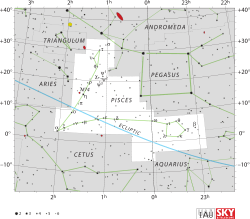Gamma Piscium

| |
| Observation data Epoch J2000.0 Equinox J2000.0 | |
|---|---|
| Constellation | Pisces |
| Right ascension | 23h 17m 09.93749s[2] |
| Declination | +03° 16′ 56.2380″[2] |
| Apparent magnitude (V) | 3.699[3] |
| Characteristics | |
| Spectral type | G9 III:[1] |
| U−B color index | +0.572 [3] |
| B−V color index | +0.924[3] |
| Astrometry | |
| Radial velocity (Rv) | -13.6[4] km/s |
| Proper motion (μ) | RA: 759.82[2] mas/yr Dec.: 17.77[2] mas/yr |
| Parallax (π) | 23.64 ± 0.18[2] mas |
| Distance | 138 ± 1 ly (42.3 ± 0.3 pc) |
| Absolute magnitude (MV) | 0.68 ± 0.08[5] |
| Details | |
| Mass | 1.03 ± 0.17[5] M☉ |
| Radius | 9.92 ± 0.42[5] R☉ |
| Surface gravity (log g) | 2.43 ± 0.06[5] cgs |
| Temperature | 4,885[5] K |
| Metallicity [Fe/H] | −0.51[5] dex |
| Age | 5.46 ± 2.50[5] Gyr |
| Other designations | |
Gamma Piscium (Gamma Psc, γ Piscium, γ Psc) is a star approximately 138 light years away from Earth,[6] in the zodiac constellation of Pisces. It is a yellow star with a spectral type of G9 III, meaning it has a surface temperature of 4,885 K and is a giant star. It is slightly cooler than the Sun, yet it is 10[5] solar radii in size and shines with the light of 61 Suns.[7] At an apparent magnitude of 3.7,[3] it is the second brightest star in the constellation Pisces, between Eta and Alpha. Once a white A2 star, it is 5.5 billion years old.
Gamma Piscium moves across the sky at three-quarters of an arcsecond per year, which at 138 light years corresponds to 153 kilometers per second. This suggests it is a visitor from another part of the Milky Way Galaxy; in astronomical terms, it will quickly leave the vicinity of the Sun. Its metallicity is only one-fourth that of the Sun, and visitors from outside the thin disk that composes the Milky Way tend to be metal-poor. It also has a low carbon-nitrogen content.[7] Gamma Piscium lies inside an asterism known as the "circlet of Pisces."[8]
Naming
In Chinese, 霹靂 (Pī Lì), meaning Thunderbolt, refers to an asterism consisting of refers to an asterism consisting of γ Piscium, β Piscium, θ Piscium, ι Piscium and ω Piscium. Consequently, γ Piscium itself is known as 霹靂二 (Pī Lì èr, English: the Second Star of Thunderbolt.)[9]
In fiction
In Frank Herbert's Dune series, Gamma Waiping (The Chinese name for Pisces) is the home system of Imperial House Corrino.
References
- 1 2 3 "Simbad Query Result", Simbad, retrieved September 30, 2007
- 1 2 3 4 5 van Leeuwen, F. (November 2007), "Validation of the new Hipparcos reduction", Astronomy and Astrophysics, 474 (2): 653–664, arXiv:0708.1752
 , Bibcode:2007A&A...474..653V, doi:10.1051/0004-6361:20078357
, Bibcode:2007A&A...474..653V, doi:10.1051/0004-6361:20078357 - 1 2 3 4 Cousins, A. W. J. (1984), "Standardization of Broadband Photometry of Equatorial Standards", South African Astronomical Observatory Circulars, 8: 59, Bibcode:1984SAAOC...8...59C
- ↑ Wielen, R.; et al. (1999), Sixth Catalogue of Fundamental Stars (FK6). Part I. Basic fundamental stars with direct solutions (35), Astronomisches Rechen-Institut Heidelberg, Bibcode:1999VeARI..35....1W
- 1 2 3 4 5 6 7 8 da Silva, L.; et al. (November 2006), "Basic physical parameters of a selected sample of evolved stars", Astronomy and Astrophysics, 458 (2): 609–623, arXiv:astro-ph/0608160
 , Bibcode:2006A&A...458..609D, doi:10.1051/0004-6361:20065105
, Bibcode:2006A&A...458..609D, doi:10.1051/0004-6361:20065105 - ↑ van Leeuwen, F. (2007), "HIP 114971", Hipparcos, the New Reduction, retrieved 2010-08-30
- 1 2 "Gamma Psc". Retrieved September 30, 2007.
- ↑ "SPACE.com -- SpaceWatch -- Pisces Rising". Retrieved September 30, 2007.
- ↑ (Chinese) AEEA (Activities of Exhibition and Education in Astronomy) 天文教育資訊網 2006 年 7 月 8 日